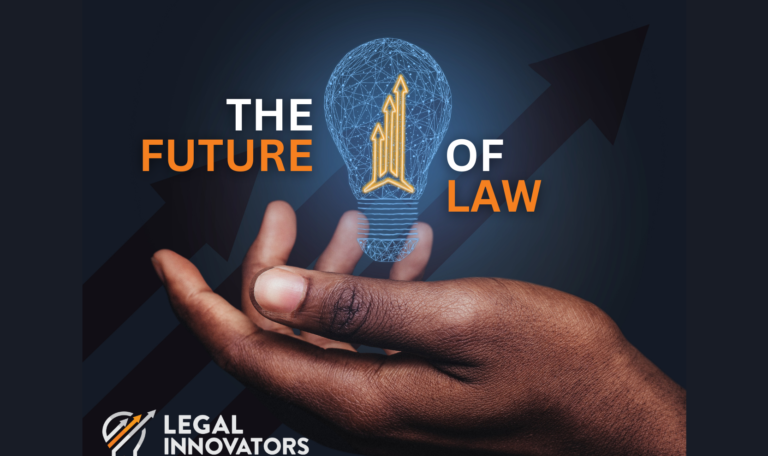On April 10th – in the middle of the COVID-19 pandemic – Legal Innovators CEO and Co-Founder Bryan Parker spoke with two of the Three Geeks, Marlene Gebauer and Greg Lambert, to talk about the Legal Innovators model and why the retention of junior legal talent today can’t be the equivalent of a coin flip.
Here’s what Greg and Marlene had to say after their conversation with Bryan:
Greg: “This issue of spending seven figures on recruits to your law firm over the years and then having the retention of your investment be essentially a coin flip…it’s something we’ve been saying for a long time now that’s ripe for disruption and it seems like Bryan is one of the people on the cusp of that wave.”
Marlene: “Exactly. This is a perfect time to start examining that because you cannot do all of the traditional things that you’ve done before. So attempting to look at this in a different way is quite timely.”
If you haven’t tuned into the Three Geeks podcast and blog yet, you’ll want add it to your list. They share resources, predictions, and strategic insights from their geeks…and guests. You can access episode #74 featuring Bryan through:
Apple Podcasts
Overcast Podcasts
Spotify
In the meantime, here are a few excerpts you won’t want to miss, including a very fun and informative segment with Bryan Parker at the very end of the episode (hint: he’s a “Sneaker Head”) . Click on each timestamp to listen to the podcast.
Bryan Parker: “We’ve gotten so carried away with the salary wars that have gone on for the last decade plus. Starting salaries for junior associates are now at $200,000. Who is the next top firm? They’re going to go to $225,000. Does anyone ever call them out on the madness or does everyone just follow them to $225,000 because you’ve got to get the best talent?
For us when you break apart the recruitment process in the law and you have 15-20 minutes on campus and you invite those people back for interviews, you’re getting to know candidates for 8-10 weeks. How much do you really know about this person? How much do they know about you?
For us the leading indicator is to look at the turnover rates in the 3rd and 4th year. It’s almost the equivalent of flipping a coin.
Let’s say you were going to invest $100,000 – $150,000 between recruiting and a summer program to get this person in the door. Including a big salary, carrying costs in their 1st and 2nd years are going to be $450,000 – $600,000. Let’s take a midpoint and say it’s $500,000. Then, let’s measure what happens at the 3rd and 4th year.
If you say, “I’ve just invested $1.2 million in this individual and I’m willing to live with a coin flip toss that the individual is still going to be here as a 3rd or 4th year”, I’d say, “Forget about the law. Take the law out for a second. I would tell you whatever industry you’re in, you’re not going to be successful. If you’re investing in talent that way, you’re watching half of it walk out the door.”
So for the invested capital that you have, you have half the people that make back your return. I have a hard time seeing the ROI in that. That’s the premise of how we think about it.
Timestamp 15:56 / The role of data and analytics in hiring junior legal talent
Bryan Parker: “I’m a data and analytics guy. I think there are predictive things you can look at – the persons’ grades, where they went to school, how they grew up, how they are mentally made up – to tell whether they are going to be a successful lawyer. In our minds, that takes more than just 2 weeks. I get it, during on campus interviews firms are bringing in 10, 25, 50 people at a time. They’ve got to go quick. But if you stick to interviewing at the top 15 or 25 schools and you’re only going to look at people in the top 10%, 15%, or 20%, you’re going to miss some folks. We try to be holistic and use all of the tools that are available to make those determinations.”
Bryan Parker: “It’s a very transactional relationship all the way down to the schools. How is the whole person being valued? How are you thinking about their career goals? How are you thinking about the kinds of things that excite their passions and make them come alive?
If you can capture in that the work you want to get done, I think it becomes a better conversation and a little bit less transactional.
Law schools have gotten better in terms of practical skills, in writing and moot court and what you do as a lawyer. But it’s unfair to think of it as just a vocation. You want people that are smart in general who can respond in different situations.
If you can get more cost effective, law firms are able to earn the profits that they want. Clients feel heard and they can save some money. And then you’re putting more jobs into the system and you’re creating that next cadre of really smart lawyers that, but the time they are in their 3rd, 4th, or 5th year, they’ll be able to return some real profitability.”
Timestamp 36:02 / The importance of diversity and inclusion
Bryan Parker: “Our model is about providing cost effective solutions where we help provide training and mentoring, but what’s also really important to us is diversity and inclusion. We have diverse and non-diverse lawyers. As a person of color, and Jon who’s not a person of color but who did found the Diversity Committee at Shearman in the early 90’s, we’ve seen by the numbers that there are still the same underrepresented groups and we wanted to do something about that. I’m a very mission and values driven leader, so any partner is going to have to share those values.”
Timestamp 37:06 / How Legal Innovators fits with law firms’ traditional partner track model
Bryan Parker: “It works in a symbiotic way. Firms have been using contract and staffing attorneys as lower cost options. That’s not what we’re saying.
We’re doing the exact same work. It’s a way to do it more cost effectively. But there’s a mix in terms of how committed law firms are to formal training programs.
If you partner with us, it’s both low cost with continual training through the whole period. We have this 2-year apprenticeship program. What we say at the beginning is, “Have a good faith look. If these people are a good cultural fit, then you’ll hire them. And if you do, everybody is in the same pool swimming toward partner in their 3rd year.
Some people don’t want to be partners. Those people that do, you’re all in the pool. If someone is coming in as a 3rd year, you’ve got 5-9 years to really prove yourself and you’ll be measured on the same categories and statistics as everyone else. Our goal is to make sure you have the same competencies as anybody else by the time you’re starting your 3rd year.
We come recognizing there is a law firm structure. We aren’t asking them to change their partnership models. We’re giving you a different launch point, helping you think about cost, and rounding out your talent.”
To learn more about our approach to recruiting, hiring, training, mentoring, diversity, and inclusion in the law, visit www.legal-innovators.com
Podcast Guest:

Bryan Parker, CEO




